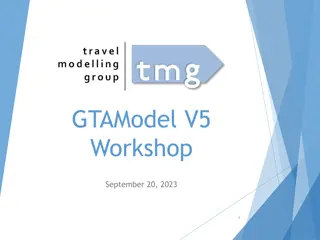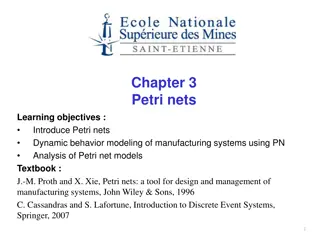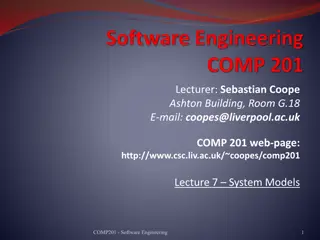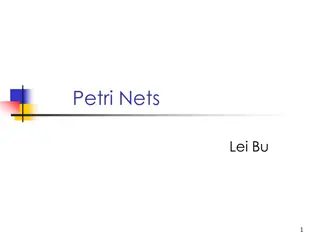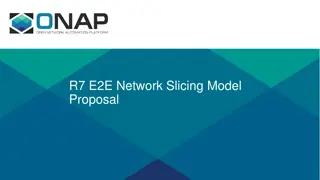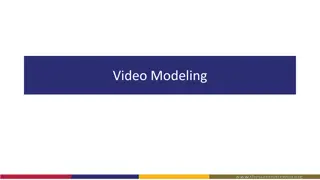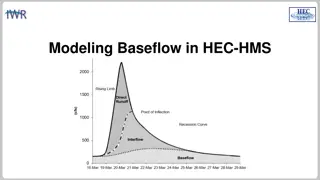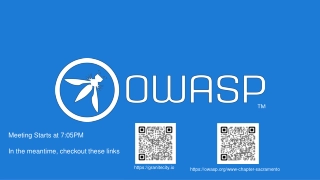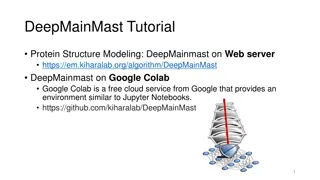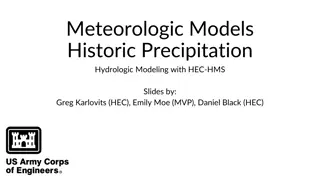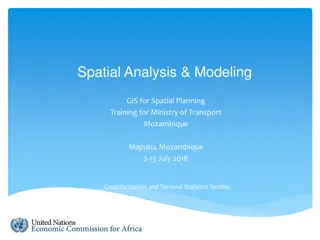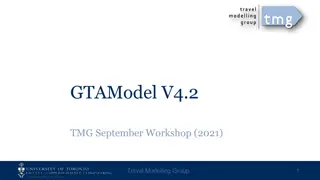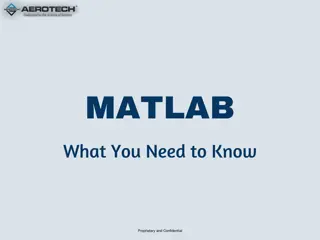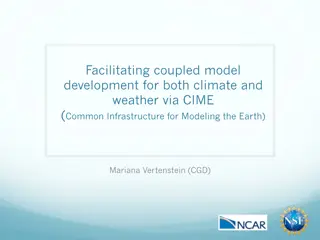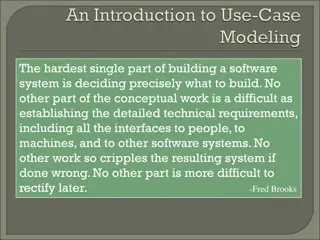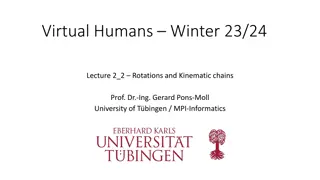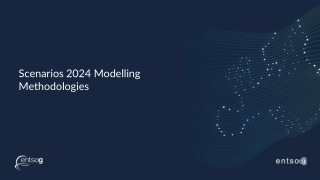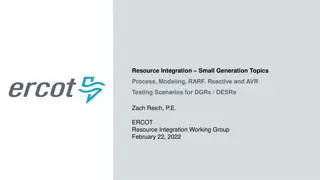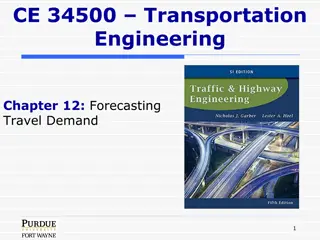Understanding Use Case Modeling in System Development
Use case modeling is a critical aspect of system development, capturing system behavior and interactions. It involves representing how a business system interacts with its environment through formal scenarios. Use cases benefit communication, identification, and verification, providing a clear understanding of system activities for stakeholders and development teams. Compared to traditional methods, use cases are user-friendly and free from technical details. Key points include stakeholder involvement in writing use cases, making them relatively easy to write and understand in the development process.
Download Presentation

Please find below an Image/Link to download the presentation.
The content on the website is provided AS IS for your information and personal use only. It may not be sold, licensed, or shared on other websites without obtaining consent from the author. Download presentation by click this link. If you encounter any issues during the download, it is possible that the publisher has removed the file from their server.
E N D
Presentation Transcript
Use Case Model Use case diagram Part 1
RelevantRequirementsArtifacts Use-Case Model Glossary Actors Use Cases ... Supplementary Specification Use-Case Specifications
W hatIs SystemBehavior? System behavior is how a system acts and reacts. It is the outwardly visible and testable activity of a system. System behavior is captured in use cases. Use cases describe the system, its environment, and the relationship between the system and its environment.
WhatAre the Benefits ofa Use-Case Model? o Communication o Identification o Verification Use Case Communication Verification Identification Users End User Domain Expert OOAD
Key points The development team, with stakeholders involvement, writes the use cases. Compared to traditional requirement methods, use cases are relatively easy to write and easier to read. Free of technical or implementation details.
Use Cases What is a Use Case A formal way of representing how a business system interacts with its environment Illustrates the activities that are performed by the users of the system A scenario-based technique in the UML
Use Case Diagrams A use case diagram depicts the interactions between the system and the external actors. 7
Use Cases Use case diagrams describe what a system does from the standpoint of an external observer. The emphasis is on what a system does rather than how. Use case diagrams are closely connected to scenarios. A scenario is an example of what happens when someone interacts with the system.
Developing use case diagram System name Actor is a stick figure usually an actual person using the system System boundary Connection line shows which actor participate in the use cases The use case 9
M ajorConcepts inUse-Case M odeling An actor represents anything that interacts with the system. An actor might be: a person a company or organization, a computer program, or a computer system Hardware Actor A use case is a sequence of actions a system performs that yields an observable result of value to a particular actor. Name each use case using Noun-Verb UseCase OOAD
Use Case Analysis What is an Actor? A user or outside system that interacts with the system being designed in order to obtain some value from that interaction Use Cases describe scenarios that describe the interaction between users of the system (the actor) and the system itself.
Questions for Identifying People Actors Who is interested in the scenario/system? Where in the organization is the scenario/system be used? Who will benefit from the use of the scenario/system? Who will supply the scenario/system with this information, use this information, and remove this information? Does one person play several different roles? Do several people play the same role?
Questions for Identifying Other Actors What other entity is interested in the scenario/system? What other entity will supply the scenario/system with this information, use this information, and remove this information? Does the system use an external resource? Does the system interact with a legacy system?
Types of actor Primary actor initiates the use case. Secondary actor is used to complete the use case. E.g. the professor send SMS to the students. The professor considered as primary actor, whereas students considered as secondary actor
Actors An Actor is outside or external the system. It can be a: Human Peripheral device (hardware) External system or subsystem Time or time-based event Represented by stick figure
A Step-by-Step Guide to Building the Use- Case Model Step 1: Identify and Describe the Actors Who uses the system? Who gets information from this system? Who provides information to the system? Where in the company is the system used? Who supports and maintains the system? What other systems use this system? 16
A Step-by-Step Guide to Building the Use- Case Model Step 2: Identify the Use Cases and Write a Brief Description What will the actor use the system for? Will the actor create, store, change, remove, or read data in the system? Will the actor need to inform the system about external events or changes? Will the actor need to be informed about certain occurrences in the system? 17
A Step-by-Step Guide to Building the Use- Case Model Step 3: Identify the Actor and Use-Case Relationships Only one actor can initiate a use case Many use cases may involve the participation of multiple actors. Each use case is analyzed to see what actors interact with it 18
Use Cases Here is a scenario for a medical clinic. A patient calls the clinic to make an appointment for a yearly checkup. The receptionist finds the nearest empty time slot in the appointment book and schedules the appointment for that time slot. " We want to write a use case for this scenario. Remember: A use case is a summary of scenarios for a single task or goal.
Use Cases Step 1 Identify the actors As we read the scenario, define those people or systems that are going to interact with the scenario. A patient calls the clinic to make an appointment for a yearly checkup. The receptionist finds the nearest empty time slot in the appointment book and schedules the appointment for that time slot. "
Use Cases A use case is a summary of scenarios for a single task or goal. An actor is who or what initiates the events involved in the task of the use case. Actors are simply roles that people or objects play. So as we read our scenario, what or who is the actor????
Use Cases So as we read our scenario, what or who is the actor???? A patient calls the clinic to make an appointment for a yearly checkup. The receptionist finds the nearest empty time slot in the appointment book and schedules the appointment for that time slot. " The actor is a Patient.
Use Cases The use case is a summary of scenarios for a single task or goal. So What is the Use Case???? The Use Case is Make Appointment. It is a use case for the medical clinic.
Use Cases The picture below is a Make Appointment use case for the medical clinic. The actor is a Patient. The connection between actor and use case is a communication association (or communication for short). Actors are stick figures. Use cases are ovals. Communications are lines that link actors to use cases. Actors are stick figures. Use cases are ovals. Communications are lines that link actors to use cases. Actors are stick figures. Use cases are ovals. Communications are lines that link actors to use cases.
Use Case Componentss The use case has three components. The use case task referred to as the use case that represents a feature needed in a software system. The actor(s) who trigger the use case to activate. The communication line to show how the actors communicate with the use case.
Use Case Each use case in a use case diagram describes one and only one function in which users interact with the system May contain several paths that a user can take while interacting with the system Each path is referred to as a scenario
Use Case Labelled using a descriptive verb-noun phrase Represented by an oval Make Appointment
Use Case - Actor Labelled using a descriptive noun or phrase Represented by a stick character
Use Case - Relationships Relationships Represent communication between actor and use case Depicted by line or double-headed arrow line Also called association relationship Make Appointment
Use Case - Relationships Boundary A boundary rectangle is placed around the perimeter of the system to show how the actors communicate with the system. Make Appointment
Use-Case Diagram A use case diagram is a collection of actors, use cases, and their communications.
CaseStudy:CourseRegistrationProblemStatement Review the problem statement provided in the Course Registration Requirements Document. Course Registration Requirements Document OOAD
H owW ouldYouReadThisDiagram? View Report Card Course Catalog Maintain Professor Information Register for Courses Student Maintain Student Information Login Registrar Select Courses to Teach Close Registration Professor Submit Grades Billing System OOA D















